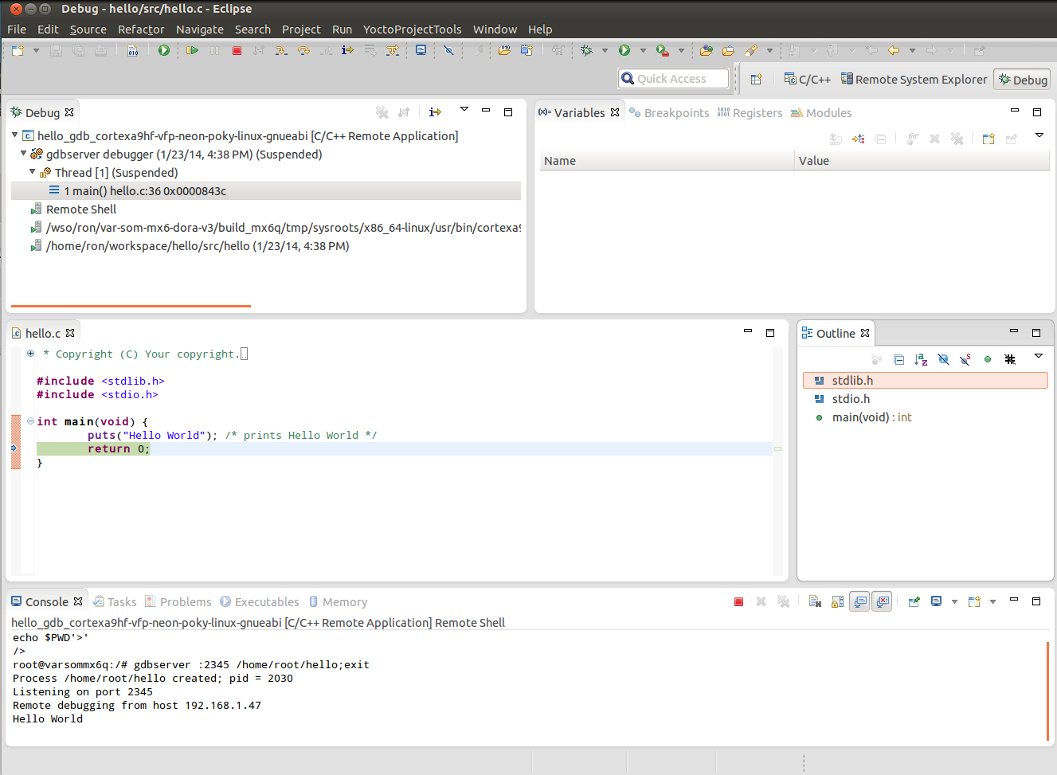VAR-SOM-MX6 Yocto Jethro Eclipse
Variscite's Yocto release includes the required packages to the build images fsl-image-qt5 with Eclipse debug support. This guide will describe how to use Eclipse to develop applications to run on the VAR-SOM-MX6.
Detail information can be found:
http://www.yoctoproject.org/docs/latest/mega-manual/mega-manual.html#application-development-workflow
previous version
Host tools
Build
Change directory to your build directory and verify that your environment settings is set correctly.
$ cd ~/var-som-mx6-yocto-jethro $ DISTRO=fsl-imx-x11 MACHINE=var-som-mx6 source var-setup-release.sh -b build_x11
Build the tools:
bitbake meta-toolchain
The build creates the tools installer
$ ls tmp/deploy/sdk/
The outcome should be:
fsl-imx-x11-glibc-x86_64-meta-toolchain-cortexa9hf-vfp-neon-toolchain-4.1.15-1.1.0.host.manifest fsl-imx-x11-glibc-x86_64-meta-toolchain-cortexa9hf-vfp-neon-toolchain-4.1.15-1.1.0.sh fsl-imx-x11-glibc-x86_64-meta-toolchain-cortexa9hf-vfp-neon-toolchain-4.1.15-1.1.0.target.manifest
Install SDK
$ tmp/deploy/sdk/fsl-imx-x11-glibc-x86_64-meta-toolchain-cortexa9hf-vfp-neon-toolchain-4.1.15-1.1.0.sh
When system prompts "Enter target directory for SDK (default: /opt/fsl-imx-x11/4.1.15-1.1.0):" hit enter.
When system prompts "You are about to install the SDK to "/opt/fsl-imx-x11/4.1.15-1.1.0". Proceed[Y/n]?" hit y and enter.
At the end of the installation you should see the following:
SDK has been successfully set up and is ready to be used. Each time you wish to use the SDK in a new shell session, you need to source the environment setup script e.g. $ . /opt/fsl-imx-x11/4.1.15-1.1.0/environment-setup-cortexa9hf-vfp-neon-poky-linux-gnueabi
Eclipse installation
Please follow : https://community.freescale.com/docs/DOC-172840
Create and run a simple application
Create the Project
You can create two types of projects: Autotools-based, or Makefile-based. This section describes how to create Autotools-based projects from within the Eclipse IDE. To create a project based on a Yocto template and then display the source code, follow these steps:
- File->New->C Project
- Click Yocto Project ADT Project.
- Select Hello World ANSI C Autotools Project. This is an Autotools-based project based on a Yocto template.
- Put a name in the Project name: field. Do not use hyphens as part of the name.
- Click "Next".
- Add information in the Author and Copyright notice fields.
- Be sure the License field is correct.
- Click "Finish".
- If the "open perspective" prompt appears, click "Yes" so that you in the C/C++ perspective.
- The left-hand navigation pane shows your project. You can display your source by double clicking the project's source file.
- "hit Ctrl B" It will build your project.
Create communication link
Using the console of your target set a password with "passwd" command. choose a simple one named "root". The target should be connected to the network via Ethernet or WIFI. Use the "ifconfig" command to get the target ip address. From Eclipse
- Window->Open Perspective->Other
- Double click on Remote System Explorer
- In the left bar right click and New->Connection
- Choose TCF and Next
- Set the Host name to the target IP
- Hit Finish
- On the left bar right click on the taget IP and select connect
- Set "User ID:" to root, "Password:" to root and check the "Save password"
- enter the root password again in the next poop up.
Once connected you can browse target file system, browse target process and lunch a terminal to the target.
Remote debug
Follow the below steps to remotely debug your application on the VAR-SOM-MX6.
- Select "Debug Configurations..." from the "Run" menu.
- In the left area, expand C/C++Remote Application.
- Locate your project and select it to pop up a new tabbed view in the Debug Configurations Dialog.
- Enter the absolute path which you want to deploy the application to. Use the "Remote Absolute File Path for C/C++Application:" field. For example, enter /home/root/hello
- Click on the "Debugger" tab to see the cross-tool debugger you are using.
- Click on the "Main" tab.
- Hit Debug
- Accept the debug perspective.








